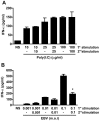Epstein-Barr virus interferes with the amplification of IFNalpha secretion by activating suppressor of cytokine signaling 3 in primary human monocytes
- PMID: 20689596
- PMCID: PMC2912847
- DOI: 10.1371/journal.pone.0011908
Epstein-Barr virus interferes with the amplification of IFNalpha secretion by activating suppressor of cytokine signaling 3 in primary human monocytes
Abstract
Background: Epstein-Barr virus is recognized to cause lymphoproliferative disorders and is also associated with cancer. Evidence suggests that monocytes are likely to be involved in EBV pathogenesis, especially due to a number of cellular functions altered in EBV-infected monocytes, a process that may affect efficient host defense. Because type I interferons (IFNs) are crucial mediators of host defense against viruses, we investigated the effect of EBV infection on the IFNalpha pathway in primary human monocytes.
Methodology/principal findings: Infection of monocytes with EBV induced IFNalpha secretion but inhibited the positive feedback loop for the amplification of IFNalpha. We showed that EBV infection induced the expression of suppressor of cytokine signaling 3 (SOCS3) and, to a lesser extent, SOCS1, two proteins known to interfere with the amplification of IFNalpha secretion mediated by the JAK/STAT signal transduction pathway. EBV infection correlated with a blockage in the activation of JAK/STAT pathway members and affected the level of phosphorylated IFN regulatory factor 7 (IRF7). Depletion of SOCS3, but not SOCS1, by small interfering RNA (siRNA) abrogated the inhibitory effect of EBV on JAK/STAT pathway activation and significantly restored IFNalpha secretion. Finally, transfection of monocytes with the viral protein Zta caused the upregulation of SOCS3, an event that could not be recapitulated with mutated Zta.
Conclusions/significance: We propose that EBV protein Zta activates SOCS3 protein as an immune escape mechanism that both suppresses optimal IFNalpha secretion by human monocytes and favors a state of type I IFN irresponsiveness in these cells. This immunomodulatory effect is important to better understand the aspects of the immune response to EBV.
Conflict of interest statement
Figures







Similar articles
-
Acute alcohol intake induces SOCS1 and SOCS3 and inhibits cytokine-induced STAT1 and STAT3 signaling in human monocytes.Alcohol Clin Exp Res. 2008 Sep;32(9):1565-73. doi: 10.1111/j.1530-0277.2008.00726.x. Epub 2008 Jul 9. Alcohol Clin Exp Res. 2008. PMID: 18616672 Free PMC article.
-
Multiple Viral microRNAs Regulate Interferon Release and Signaling Early during Infection with Epstein-Barr Virus.mBio. 2021 Mar 30;12(2):e03440-20. doi: 10.1128/mBio.03440-20. mBio. 2021. PMID: 33785626 Free PMC article.
-
Japanese encephalitis virus infection modulates the expression of suppressors of cytokine signaling (SOCS) in macrophages: implications for the hosts' innate immune response.Cell Immunol. 2013 Sep-Oct;285(1-2):100-10. doi: 10.1016/j.cellimm.2013.09.005. Epub 2013 Oct 3. Cell Immunol. 2013. PMID: 24140964
-
[Molecular mechanisms for suppression of interferon signal transduction pathways caused by viral infections].Uirusu. 2004 Dec;54(2):169-78. doi: 10.2222/jsv.54.169. Uirusu. 2004. PMID: 15745154 Review. Japanese.
-
IRF7: activation, regulation, modification and function.Genes Immun. 2011 Sep;12(6):399-414. doi: 10.1038/gene.2011.21. Epub 2011 Apr 14. Genes Immun. 2011. PMID: 21490621 Free PMC article. Review.
Cited by
-
Oncogenic Viruses as Entropic Drivers of Cancer Evolution.Front Virol. 2021 Nov;1:753366. doi: 10.3389/fviro.2021.753366. Epub 2021 Nov 15. Front Virol. 2021. PMID: 35141704 Free PMC article.
-
Manipulation of Type I Interferon Signaling by HIV and AIDS-Associated Viruses.J Immunol Res. 2019 Apr 4;2019:8685312. doi: 10.1155/2019/8685312. eCollection 2019. J Immunol Res. 2019. PMID: 31089479 Free PMC article. Review.
-
Virus-Induced Tumorigenesis and IFN System.Biology (Basel). 2021 Oct 1;10(10):994. doi: 10.3390/biology10100994. Biology (Basel). 2021. PMID: 34681093 Free PMC article. Review.
-
Comprehensive insight into altered host cell-signaling cascades upon Helicobacter pylori and Epstein-Barr virus infections in cancer.Arch Microbiol. 2023 Jun 13;205(7):262. doi: 10.1007/s00203-023-03598-6. Arch Microbiol. 2023. PMID: 37310490 Review.
-
Negative regulation of type I interferon signaling by integrin-linked kinase permits dengue virus replication.PLoS Pathog. 2023 Mar 17;19(3):e1011241. doi: 10.1371/journal.ppat.1011241. eCollection 2023 Mar. PLoS Pathog. 2023. PMID: 36930690 Free PMC article.
References
-
- Straus SE, Cohen JI, Tosato G, Meier J. NIH conference. Epstein-Barr virus infections: biology, pathogenesis, and management. Ann Intern Med. 1993;118:45–58. - PubMed
-
- Kasahara Y, Yachie A. Cell type specific infection of Epstein-Barr virus (EBV) in EBV-associated hemophagocytic lymphohistiocytosis and chronic active EBV infection. Crit Rev Oncol Hematol. 2002;44:283–294. - PubMed
-
- Savard M, Gosselin J. Epstein-Barr virus immunossuppression of innate immunity mediated by phagocytes. Virus Res. 2006;119:134–145. - PubMed
-
- Gosselin J, Menezes J, D'Addario M, Hiscott J, Flamand L, et al. Inhibition of tumor necrosis factor-alpha transcription by Epstein-Barr virus. Eur J Immunol. 1991;21:203–208. - PubMed
-
- Jabs WJ, Wagner HJ, Maurmann S, Hennig H, Kreft B. Inhibition of macrophage inflammatory protein-1 alpha production by Epstein-Barr virus. Blood. 2002;99:1512–1516. - PubMed
Publication types
MeSH terms
Substances
Grants and funding
LinkOut - more resources
Full Text Sources

